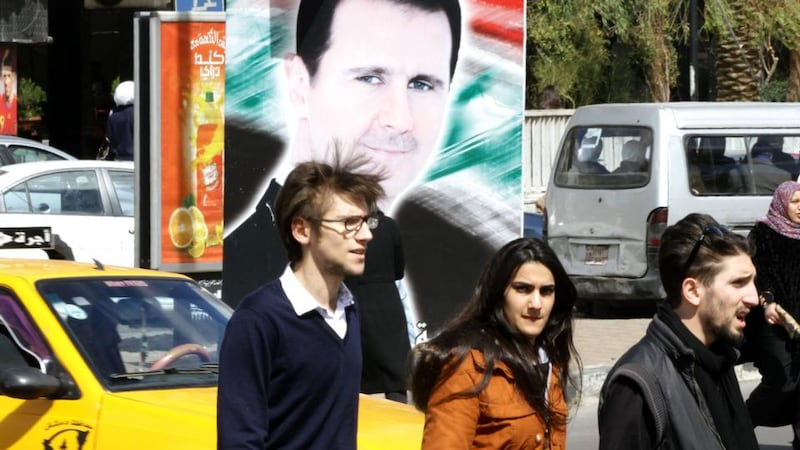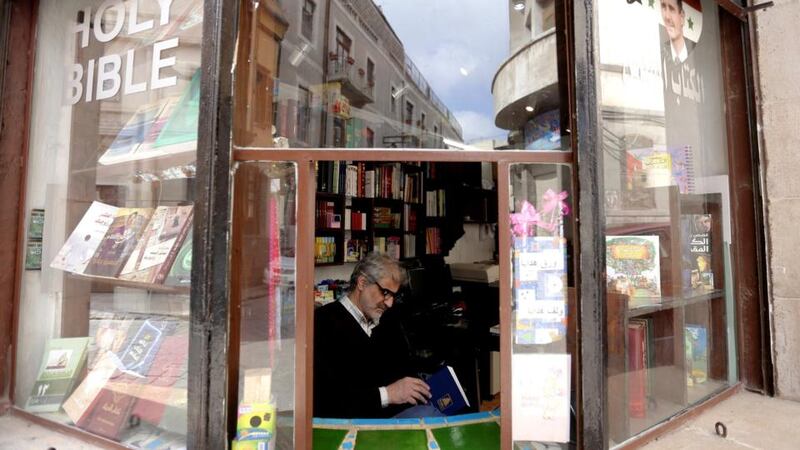The avenues and streets of Damascus are alive with the thrum of traffic, the pavements with the tramp of feet of hundreds of thousands of Syrians who have flocked to the capital from across the country.
Cars are locked in jams, pedestrians march shoulder to shoulder. Men in smart suits are armed with mobile phones, university students with book bags. Girls in tight trousers, headscarved or hair flowing, are still in boots and warm jackets as chill showers have replaced an early spring.
Vendors hawk cheap plastic wares, cigarettes and crumpled second-hand clothes. Generators clack and splutter during power cuts. White bin lorries, a spray of tulips painted on the sides, collect refuse from corner bins. Cars park three deep on side roads, hard-pressed traffic police keep some semblance of order at junctions and pedestrian crossings.


In the evenings, youngsters gather in cafes, smoke water pipes and drink tea, window shop, or sit on benches in parks and chat.
Damascus is not dying but bursting at the seams with people from its battered suburbs and across Syria who come here to find safety, food and jobs. People chased from homes, to one refuge after another, to Damascus.
Ancient oasis
Four years into the country’s civil war, Damascus, an ancient oasis, is Syria’s largest city, replacing
Aleppo
, the former commercial hub, divided and humbled by fighting. Of 18 million Syrians who reside in the country, nearly half live here. Both Damascenes and the internally displaced are struggling to make ends meet. Salaries are low, prices high and unemployment soars to 60 per cent in some areas.
Four million Syrians have fled the country, six million their homes, and 220,000 have been killed since March 15th, 2011, after reform and democracy demonstrations were met by a harsh crackdown by the government. This developed into a brutal civil conflict that, in 2013, became an international war that has drawn in the holy warriors of Islamic State (IS).
The Damascus envelope, where the government reigns, has also grown on the ground as the army has driven insurgents from outlying districts, some of which have been reduced to rubble.
While volleys of rockets and mortars still come from the insurgent-held Eastern Ghouta and Douma to the north, they are fewer than in June when I was last here. Nights are less disturbed by the flat, metallic report of artillery shells fired by the army into insurgent-held areas and the muffled thump of their landings. But there is neither peace nor safety.
Sitting in her office in the massive presidential palace on a wooded hill overlooking the city, president Bashar al-Assad's media and political adviser Bouthaina Shaaban tells The Irish Times, "Every Syrian feels there has been a change over the past year."
She claims the army is taking the initiative and "liberating" areas held by a variety of mainly fundamentalist insurgent factions, including IS and al-Qaeda affiliate Jabhat al-Nusra.
Nevertheless, she says, “The Syrian people have accommodated themselves to the fact that the war is going to last.”
Just off Rawda Square, plumes of water rising from the fountain sparkle in the sun. At the nearby office of the International Committee of the Red Cross, Assem Elessawy, agency field co-ordinator, agrees that during 2014 "the government really progressed in terms of getting the situation under control".
“Aleppo is better [than it was]. Nearly 70 per cent of the city is controlled by the government while 30 per cent and the rural surroundings are controlled by the opposition.”
The warring sides form layers of encirclement, trapping Aleppo. To cross from one sector to the other can take seven hours because of the need to take a circuitous route. The situation in Raqqa and Deir al-Zor [held by IS] is describ ed as dire.
Iran is providing military aid to government forces which have not only made gains in Damascus and Aleppo but also hold the coast.
Jabhat al-Nusra is dominant in the northwest while IS holds Raqqa in the north-central sector and Deir al-Zor in the east on the Iraqi frontier. Jihadis continue to pour across the Turkish border. The US-led coalition bombs IS on the outskirts of Raqqa and along the Turkish border but the campaign is not co-ordinated with anti-IS operations on the ground.
External involvement
Both pro- and anti-government Syrians agree there is no military solution but that prospects for a political settlement are poor. Competing external powers involved in the conflict have not decided what to do about Syria.
Saudi Arabia
,
Qatar
and
Turkey
continue to give priority to the ousting of Assad in spite of the global threat posed by IS.
The western and Arab-supported opposition Syrian National Coalition has now agreed that Assad should remain through the transition rather than leaving before it begins, a position adopted by Washington last November. According to a diplomatic source, France and Britain continue to adopt a hard line position on Assad while Germany is moving toward the view taken by Italy, Spain and Greece that he must be part of the solution.
Facing jihadis in their Arab backyard and at home, some European countries are becoming “more realistic but not realistic enough”, says Anas Joudeh of the domestic opposition group, Building the Syrian State.
The US follows conflicting policies, bombing IS while training and arming insurgents who will ultimately join IS or Jabhat al-Nusra, he argues.
Russia held one round of talks between government and opposition figures and another is expected in April but there is no detailed plan, says Joudeh. "But we have to keep working for unity and a roadmap. We have no choice."











